Reduction of Heating Energy Demand by Combining Infrared Heaters and Infrared Reflective Walls
Abstract
:1. Introduction
1.1. Motivation
1.2. Research and Typical Applications
1.3. Structure of the Paper
2. Methods
2.1. Geometry and General Setup of the Simulation
2.2. Design of Experiments
- Wall temperature, including ceiling and floor:
- Air inlet temperature:
- Wall emissivity, including ceiling and floor:
- Area specific heating power: ()
2.3. Model
3. Results and Discussion
3.1. Simulation
3.2. Response Surface
4. Conclusions
Author Contributions
Funding
Data Availability Statement
Conflicts of Interest
Abbreviations
| CCD | Central Composite Design |
| IR | Infrared |
| PMV | Predicted Mean Vote |
| PPD | Predicted Percentage Dissatisfied |
Appendix A
Appendix A.1

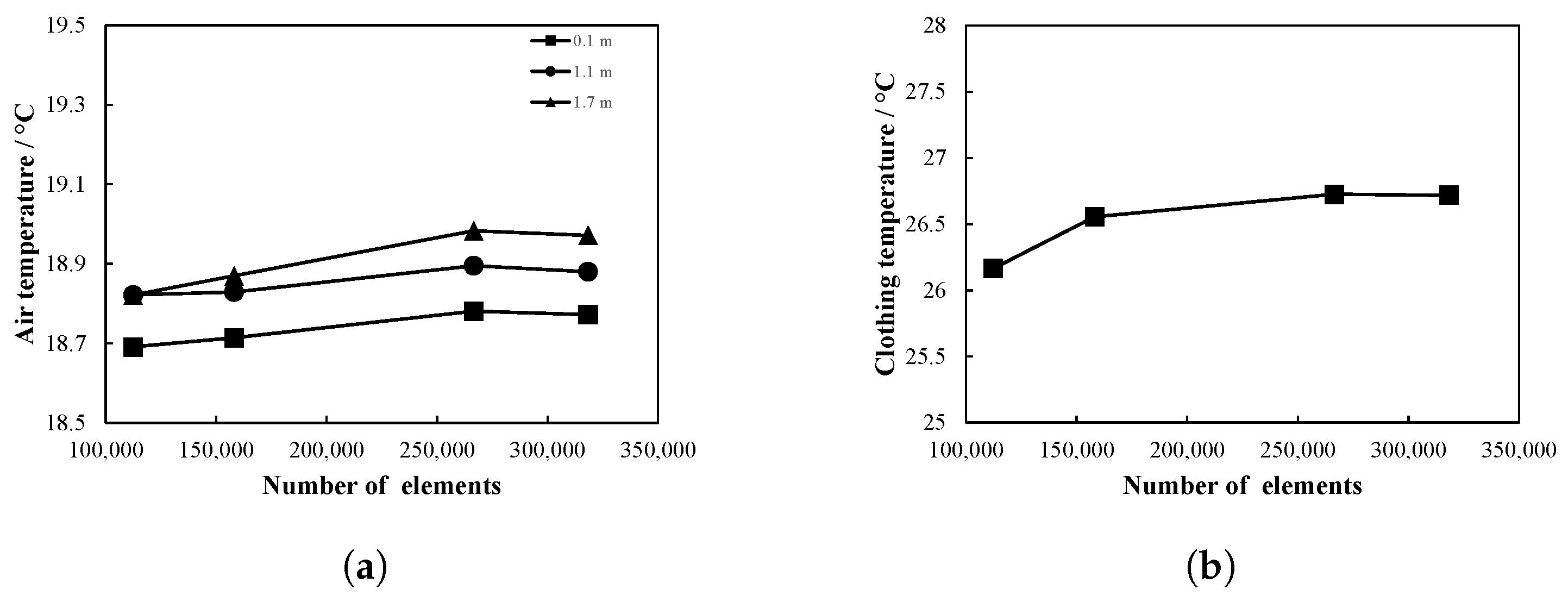
Appendix A.2
| No. | ||||
|---|---|---|---|---|
| 1 | −1 | −1 | −1 | −1 |
| 2 | −1 | 1 | −1 | −1 |
| 3 | 1 | −1 | −1 | −1 |
| 4 | 1 | 1 | −1 | −1 |
| 5 | −1 | −1 | 1 | −1 |
| 6 | −1 | 1 | 1 | −1 |
| 7 | 1 | −1 | 1 | −1 |
| 8 | 1 | 1 | 1 | −1 |
| 9 | −1 | −1 | −1 | 1 |
| 10 | −1 | 1 | −1 | 1 |
| 11 | 1 | −1 | −1 | 1 |
| 12 | 1 | 1 | −1 | 1 |
| 13 | −1 | −1 | 1 | 1 |
| 14 | −1 | 1 | 1 | 1 |
| 15 | 1 | −1 | 1 | 1 |
| 16 | 1 | 1 | 1 | 1 |
| 17 | 0 | 0 | 0 | −1.547 |
| 18 | 0 | 0 | 0 | 1.547 |
| 19 | 0 | 0 | −1.547 | 0 |
| 20 | 0 | 0 | 1.547 | 0 |
| 21 | −1.547 | 0 | 0 | 0 |
| 22 | 1.547 | 0 | 0 | 0 |
| 23 | 0 | −1.547 | 0 | 0 |
| 24 | 0 | 1.547 | 0 | 0 |
| 25 (CP1) | 0 | 0 | 0 | 0 |
| 26 (CP2) | 0 | 0 | 0 | 0 |
| 27 (CP3) | 0 | 0 | 0 | 0 |
Appendix A.3
References
- King, D. Engineering a Low Carbon Built Environment: The Discipline of Building Engineering Physics; The Royal Academy of Engineering: London, UK, 2010. [Google Scholar]
- Shafiee, S.; Topal, E. A long-term view of worldwide fossil fuel prices. Appl. Energy 2010, 87, 988–1000. [Google Scholar] [CrossRef]
- Statista Research Department. Durchschnittlicher Verbraucherpreis für Leichtes Heizöl in Deutschland in den Jahren 1960 bis 2024. Available online: https://de.statista.com/statistik/daten/studie/2633/umfrage/entwicklung-des-verbraucherpreises-fuer-leichtes-heizoel-seit-1960/ (accessed on 8 April 2024).
- Bergman, N. Why is renewable heat in the UK underperforming? A socio-technical perspective. Proc. Inst. Mech. Eng. Part A J. Power Energy 2013, 227, 124–131. [Google Scholar] [CrossRef]
- Opel, O. Warmwasserbereitung als Hemmschuh der Energiewende—Technische, Hygienische und Rechtliche Konfliktpunkte Zwischen Wärmepumpeneinsatz und Trinkwarmwasserbereitung; Gesellschaft für Energie und Klimaschutz Schleswig-Holstein GmbH: Kiel, Germany, 2023. [Google Scholar]
- Heider, J.; Conrad, N.; Stark, T.; Abdulganiev, A.; Kosack, P.; Wagner, A.K. Forschungsprojekt IR Bau; HTWG Konstanz: Konstanz, Germany, 2020. [Google Scholar]
- Fanger, P.O. Thermal Comfort: Analysis and Applications in Environmental Engineering; McGraw-Hill: New York, NY, USA, 1970. [Google Scholar]
- ISO 7730:2005; Ergonomics of the Thermal Environment—Analytical Determination and Interpretation of Thermal Comfort Using Calculation of the PMV and PPD Indices and Local Thermal Comfort Criteria. Technical Report. International Organization for Standardization: Geneva, Switzerland, 2005.
- Kosack, P. Leitfaden Infrarotheizung; IG Infrarot Deutschland: Sauerlach, Germany, 2021. [Google Scholar]
- Statistisches Bundesamt. 57% der im Jahr 2022 Gebauten Wohngebäude Heizen mit Wärmepumpen. Available online: https://www.destatis.de/DE/Presse/Pressemitteilungen/2023/06/PD23_N034_31121.html (accessed on 19 October 2023).
- Lazzarin, R. Dual source heat pump systems: Operation and performance. Energy Build. 2012, 52, 77–85. [Google Scholar] [CrossRef]
- Bundesamt für Wirtschaft und Ausfuhrkontrolle. Bundesförderung für Effiziente Gebäude—Infoblatt zu den Förderfähigen Maßnahmen und Leistungen. Available online: https://www.bafa.de/SharedDocs/Downloads/DE/Energie/beg_infoblatt_foerderfaehige_kosten.html (accessed on 1 December 2023).
- Xu, J.; Raman, A.P. Controlling radiative heat flows in interior spaces to improve heating and cooling efficiency. iScience 2021, 24, 102825. [Google Scholar] [CrossRef] [PubMed]
- Malz, S.; Krenkel, W.; Steffens, O. Infrared reflective wall paint in buildings: Energy saving potentials and thermal comfort. Energy Build. 2020, 224, 110212. [Google Scholar] [CrossRef]
- Gläser, H. Improved insulating glass with low emissivity coatings based on gold, silver, or copper films embedded in interference layers. Glass Technol. 1980, 21, 254–261. [Google Scholar]
- Verbraucherzentrale Thüringen. Energiesparfarbe: Zu Schön, um Wahr zu Sein. Available online: https://www.vzth.de/pressemeldungen/energie/energiesparfarbe-zu-schoen-um-wahr-zu-sein-82255 (accessed on 4 October 2023).
- Verbraucherzentrale Thüringen. Verbraucherzentrale Energieberatung Warnt vor „Energiesparfarbe“. Available online: https://wdvs.enbausa.de/nachrichten/verbraucherzentrale-energieberatung-warnt-vor-energiesparfarbe (accessed on 4 October 2023).
- Kosack, P. Beispielhafte Vergleichsmessung Zwischen Infrarotstrahlungsheizung und Gasheizung im Altbaubereich; TU Kaiserslautern: Kaiserslautern, Germany, 2009. [Google Scholar]
- Siebertz, K.; van Bebber, D.; Hochkirchen, T. Statistische Versuchsplanung: Design of Experiments (DoE); VDI-Buch; Springer: Berlin/Heidelberg, Germany, 2017. [Google Scholar]
- Tartarini, F.; Schiavon, S. pythermalcomfort: A Python package for thermal comfort research. SoftwareX 2020, 12, 100578. [Google Scholar] [CrossRef]
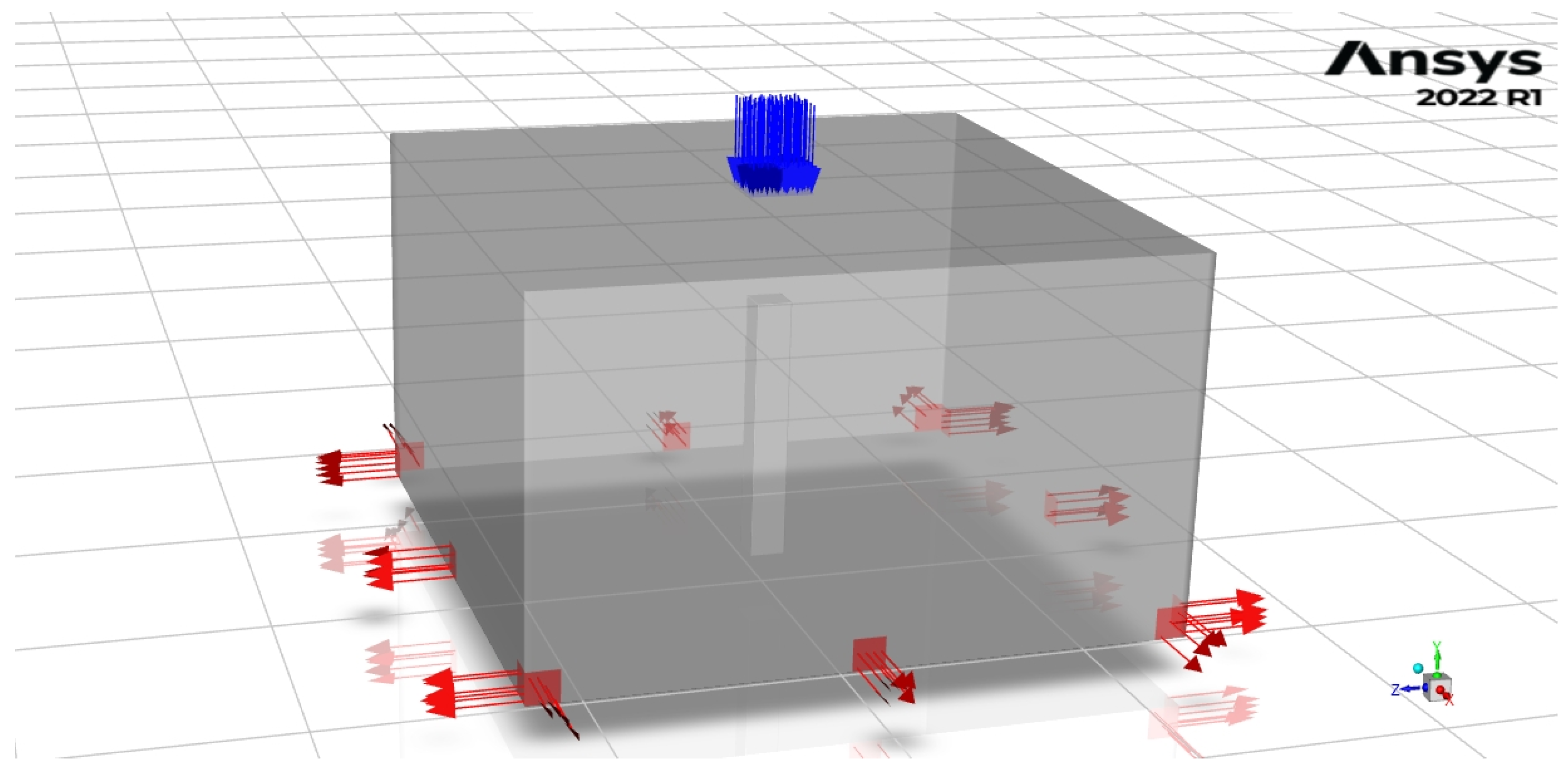
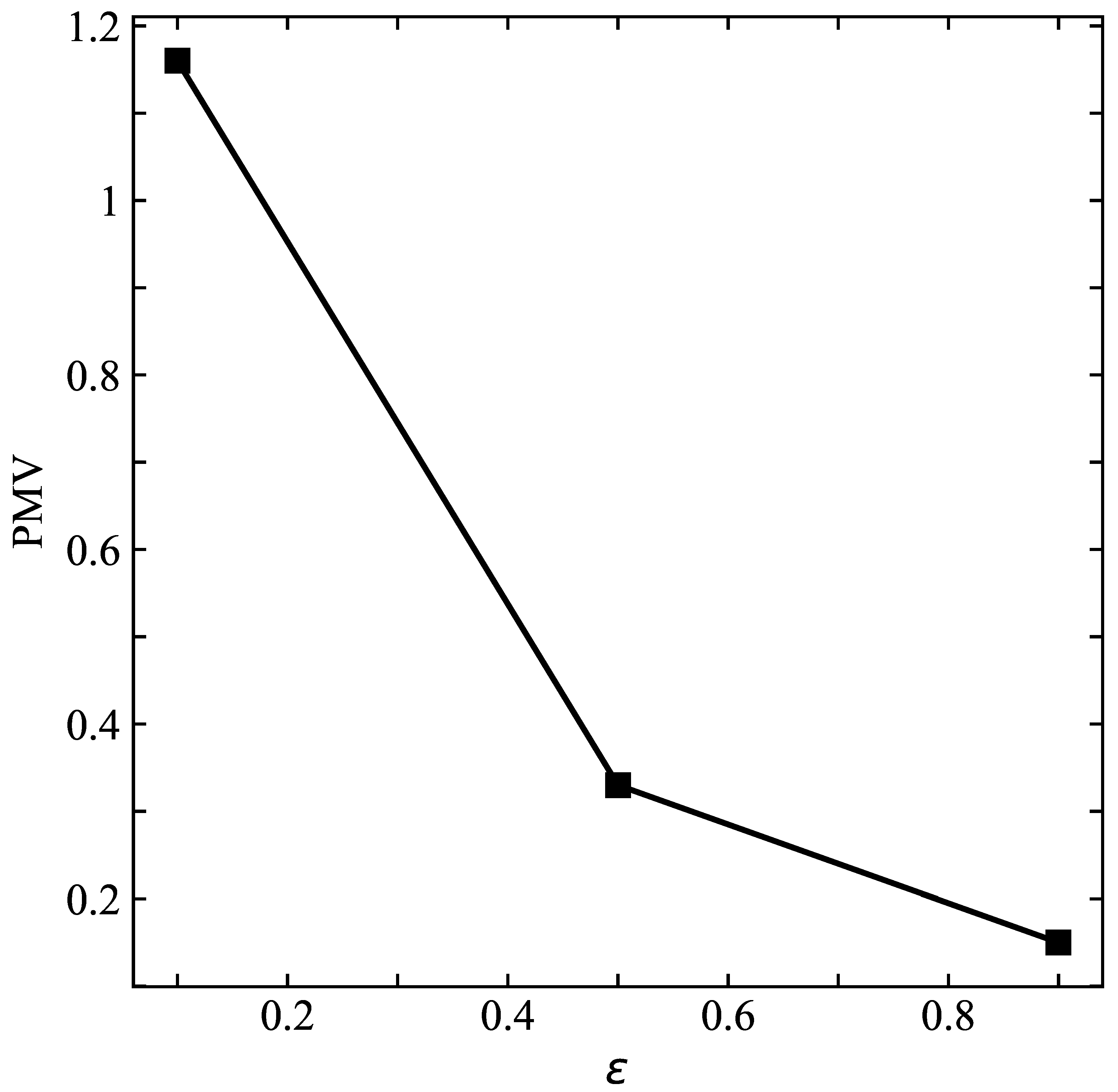
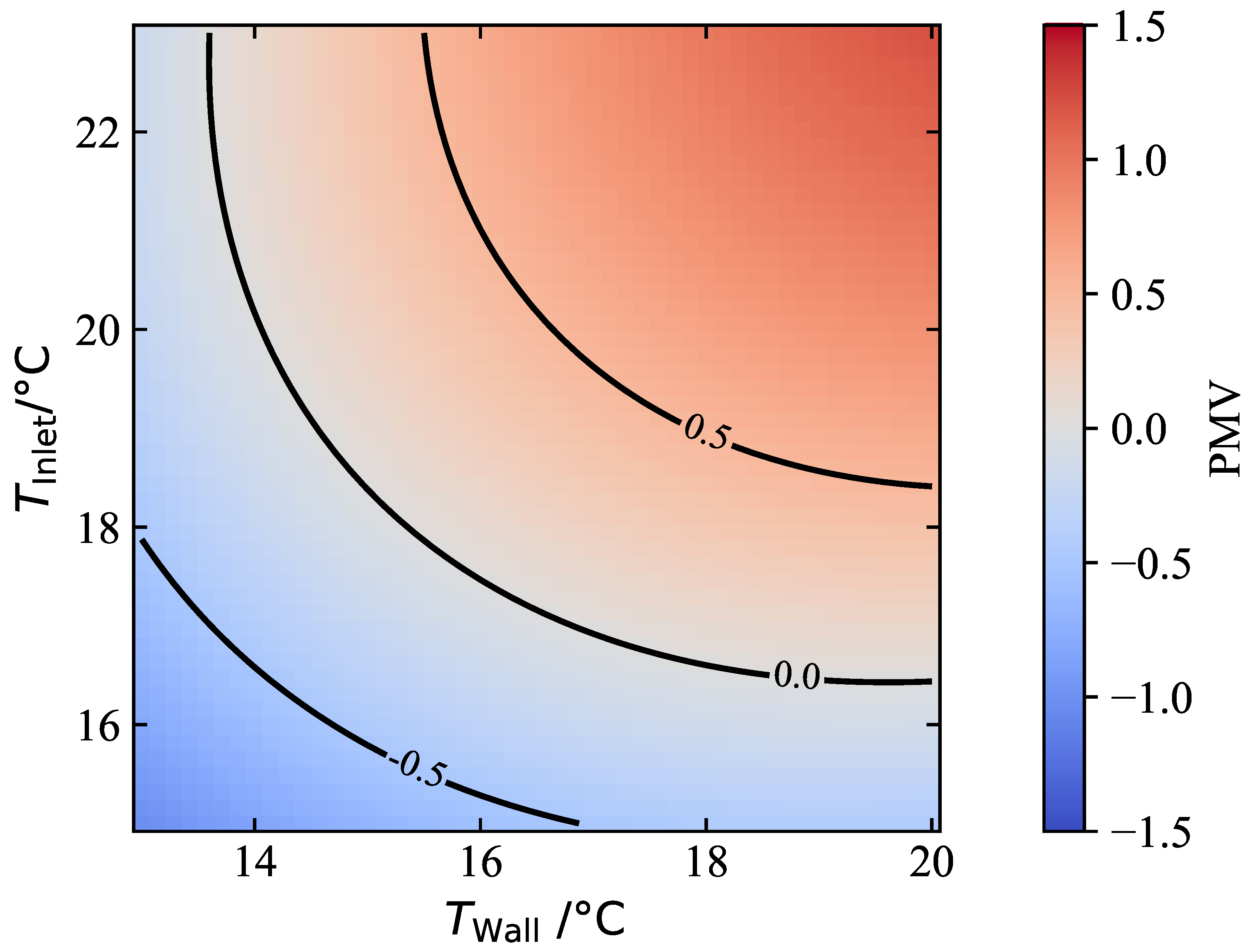
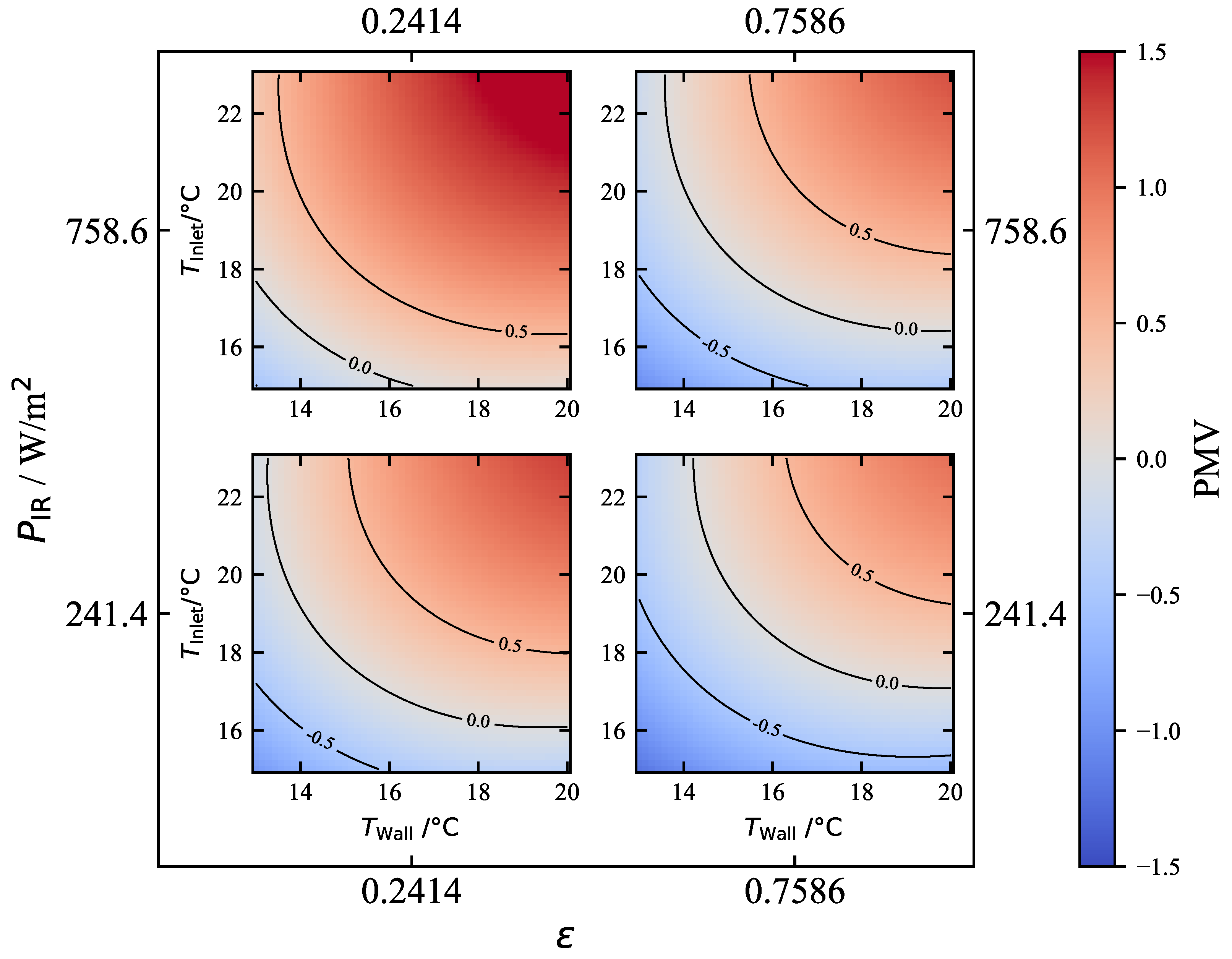
| No. | PMV | ||||||
|---|---|---|---|---|---|---|---|
| - | - | ||||||
| 1 | 14.24 | 16.41 | 0.24 | 241.4 | 16.24 | 24.20 | −0.46 |
| 2 | 14.24 | 21.59 | 0.24 | 241.4 | 19.45 | 26.33 | 0.21 |
| 3 | 18.76 | 16.41 | 0.24 | 241.4 | 17.94 | 25.80 | 0.03 |
| 4 | 18.76 | 21.59 | 0.24 | 241.4 | 21.13 | 28.89 | 0.98 |
| 5 | 14.24 | 16.41 | 0.76 | 241.4 | 16.23 | 23.45 | −0.68 |
| 6 | 14.24 | 21.59 | 0.76 | 241.4 | 19.43 | 25.55 | −0.02 |
| 7 | 18.76 | 16.41 | 0.76 | 241.4 | 17.92 | 25.30 | −0.12 |
| 8 | 18.76 | 21.59 | 0.76 | 241.4 | 21.10 | 28.20 | 0.78 |
| 9 | 14.24 | 16.41 | 0.24 | 758.6 | 16.62 | 25.82 | 0.01 |
| 10 | 14.24 | 21.59 | 0.24 | 758.6 | 19.80 | 27.86 | 0.66 |
| 11 | 18.76 | 16.41 | 0.24 | 758.6 | 18.34 | 27.05 | 0.40 |
| 12 | 18.76 | 21.59 | 0.24 | 758.6 | 21.51 | 30.57 | 1.47 |
| 13 | 14.24 | 16.41 | 0.76 | 758.6 | 16.51 | 24.30 | −0.43 |
| 14 | 14.24 | 21.59 | 0.76 | 758.6 | 19.74 | 26.19 | 0.17 |
| 15 | 18.76 | 16.41 | 0.76 | 758.6 | 18.30 | 25.77 | 0.02 |
| 16 | 18.76 | 21.59 | 0.76 | 758.6 | 21.45 | 28.93 | 1.00 |
| 17 | 16.5 | 19 | 0.5 | 100 | 18.52 | 26.16 | 0.14 |
| 18 | 16.5 | 19 | 0.5 | 900 | 19.08 | 27.39 | 0.51 |
| 19 | 16.5 | 19 | 0.1 | 500 | 18.97 | 29.65 | 1.16 |
| 20 | 16.5 | 19 | 0.9 | 500 | 18.87 | 26.17 | 0.15 |
| 21 | 13 | 19 | 0.5 | 500 | 17.55 | 24.62 | −0.32 |
| 22 | 20 | 19 | 0.5 | 500 | 20.08 | 27.88 | 0.67 |
| 23 | 16.5 | 15 | 0.5 | 500 | 16.31 | 24.18 | −0.47 |
| 24 | 16.5 | 23 | 0.5 | 500 | 21.34 | 28.06 | 0.74 |
| 25 (CP1) | 16.5 | 19 | 0.5 | 500 | 18.83 | 26.8 | 0.33 |
| 26 (CP2) | 16.5 | 19 | 0.5 | 500 | 18.83 | 26.8 | 0.33 |
| 27 (CP3) | 16.5 | 19 | 0.5 | 500 | 18.83 | 26.8 | 0.33 |
Disclaimer/Publisher’s Note: The statements, opinions and data contained in all publications are solely those of the individual author(s) and contributor(s) and not of MDPI and/or the editor(s). MDPI and/or the editor(s) disclaim responsibility for any injury to people or property resulting from any ideas, methods, instructions or products referred to in the content. |
© 2024 by the authors. Licensee MDPI, Basel, Switzerland. This article is an open access article distributed under the terms and conditions of the Creative Commons Attribution (CC BY) license (https://creativecommons.org/licenses/by/4.0/).
Share and Cite
Wille, L.A.; Schiricke, B.; Gehrke, K.; Hoffschmidt, B. Reduction of Heating Energy Demand by Combining Infrared Heaters and Infrared Reflective Walls. Buildings 2024, 14, 2183. https://doi.org/10.3390/buildings14072183
Wille LA, Schiricke B, Gehrke K, Hoffschmidt B. Reduction of Heating Energy Demand by Combining Infrared Heaters and Infrared Reflective Walls. Buildings. 2024; 14(7):2183. https://doi.org/10.3390/buildings14072183
Chicago/Turabian StyleWille, Lukas Anselm, Björn Schiricke, Kai Gehrke, and Bernhard Hoffschmidt. 2024. "Reduction of Heating Energy Demand by Combining Infrared Heaters and Infrared Reflective Walls" Buildings 14, no. 7: 2183. https://doi.org/10.3390/buildings14072183





